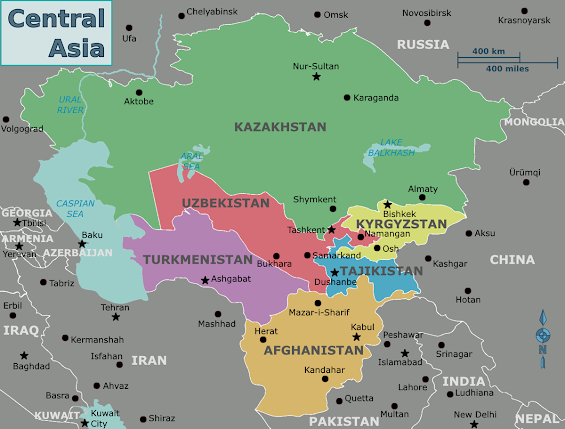Rediscovering the Legacy of Hindu Influence in Central Asia
Intro:
Welcome to a journey back in time to explore the lesser-known history of Central Asia. While Central Asia is often associated with the Silk Road, nomadic cultures, and Islamic influences, it is also a region that has been deeply influenced by Hindu civilization. In this blog, we will uncover the fascinating story of Hindu invasions and their impact on the culture, art, and architecture of Central Asia.
History:
The history of Hindu influence in Central Asia dates back to ancient times when the region was part of the Indian subcontinent. The famous Indian epic, the Mahabharata, mentions the region of Gandhara, which is identified with present-day Afghanistan. Hindu kingdoms, such as the Kushan Empire (1st to 3rd century CE), ruled over vast parts of Central Asia, including modern-day Afghanistan, Tajikistan, and Uzbekistan.
These Hindu kingdoms played a pivotal role in spreading Hindu culture, religion, and art in the region. They built magnificent temples, stupas, and monasteries, which served as centers of learning and spiritual practices. The Gandhara school of art, which flourished in Central Asia during this period, is known for its unique blend of Indian, Greek, and Persian artistic styles and is considered a significant contribution to the world of art.
Art and Architecture:
The influence of Hindu civilization in Central Asia is evident in the region's art and architecture. The famous Bamiyan Buddhas, carved into the cliffs of Afghanistan's Bamiyan Valley, are believed to have been influenced by Hindu artistic traditions. The sculptures, which were destroyed by the Taliban in 2001, were believed to have been created during the Kushan period and display a fusion of Indian and Greek artistic styles.
Another example of Hindu influence in Central Asian architecture is the Kalon Minaret in Bukhara, Uzbekistan. Built in the 12th century, the minaret is adorned with intricate geometric patterns and inscriptions in Sanskrit, which testify to its Hindu origins.
Culture:
Hindu influence is also evident in the culture of Central Asia. Many of the cultural practices, customs, and traditions in the region show Hindu influences. For example, the festival of Navruz, celebrated in Central Asian countries, including Tajikistan, Uzbekistan, and Kazakhstan, is believed to have its roots in Hindu festivals such as Holi and Diwali. The concept of the Navagrahas (nine celestial deities) in Hinduism is also believed to have influenced Central Asian astrology and is reflected in their traditional practices.
The legacy of Hindu influence is also preserved in Central Asian folktales, legends, and languages. Sanskrit, the ancient Indian language, has left its imprint on many Central Asian languages, including Pashto, Tajik, and Uzbek.
Tourism:
For travelers interested in exploring the Hindu legacy in Central Asia, there are several must-visit destinations. One of them is the city of Taxila in present-day Pakistan, which was an important center of Buddhist and Hindu learning during the Kushan period. The ruins of Taxila's ancient universities, stupas, and monasteries are a testament to the Hindu influence in the region.
Another must-visit destination is the ancient city of Samarkand in Uzbekistan, which was an important center of the Silk Road and a melting pot of various cultures, including Hindu, Greek, Persian, and Chinese. The Registan Square, with its stunning madrasas adorned with intricate tile work and calligraphy, is believed to have been influenced by Hindu architectural styles.
The city of Termez in Uzbekistan is another important destination for exploring Hindu influence. The Fayaz Tepe archaeological site in Termez has revealed ancient Hindu temples, sculptures, and artifacts that provide insights into the region's Hindu past.
Cuisine:
The Hindu influence in Central Asia is also reflected in the region's cuisine. Many Central Asian dishes have Hindu origins, such as the popular Uzbek dish called "samsa," which is similar to the Indian samosa. The use of spices, such as cumin, coriander, and cardamom, in Central Asian cuisine is believed to have been introduced by Hindu traders who traveled along the Silk Road.
Traditions and Festivals:
Central Asia is home to several traditional practices and festivals that have Hindu influences. For example, the traditional dance form called "Attan" in Afghanistan is believed to have originated from the Hindu dance form called "Ardhanarishvara," which depicts the half-male, half-female form of the Hindu deity Shiva.
The festival of "Nowruz," celebrated in Central Asian countries, marks the beginning of the Persian New Year and has its roots in Hindu festivals such as Holi and Diwali. The festival is celebrated with traditional music, dance, and food, and is a time for family gatherings and festive celebrations, much like Hindu festivals in India.
In conclusion, the Hindu influence in Central Asia is a fascinating aspect of the region's history and culture. The legacy of Hindu kingdoms that once ruled over Central Asia is evident in its art, architecture, cuisine, traditions, and festivals. Exploring this lesser-known aspect of Central Asian history offers a unique perspective on the region's cultural diversity and the interconnectedness of different civilizations throughout history. So, on your next trip to Central Asia, be sure to delve into the rich Hindu heritage that has left its mark on this region and discover the unique cultural tapestry that Central Asia has to offer. Happy travels!






No comments